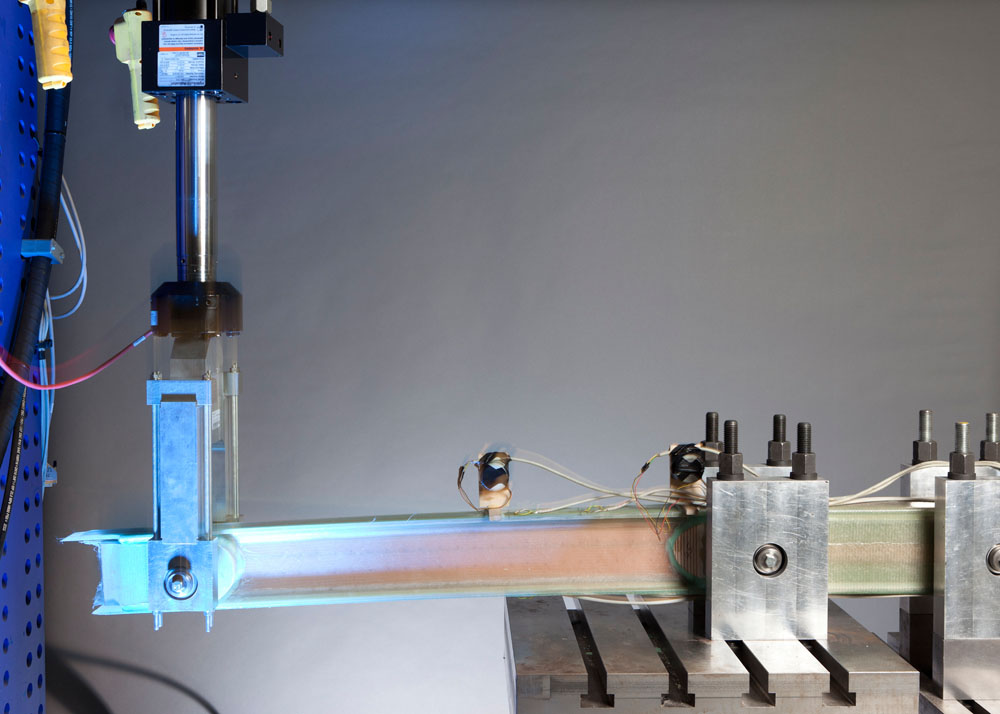
Material testing delivers the results for the structural design of rotor blades. The IWES Northwest has years of experience in the fields of fibre-composites, static and fatigue composite testing. Component and substructure testing can significantly reduce the risk of damage during a rotor blade’s operational life.
A comprehensive test and measuring infrastructure is available for determining material characteristics. The servo-hydraulic test machines are equipped with especially stiff and precise clamping tools developed for testing fibre-composite test specimens under dynamic loads. The parallel simulation of climatic and mechanical loads which takes place in a climate chamber is standard compliant (DIN/ISO), controllable and reproducible.
Depending on demand, materials such as fabrics, resins or foams are investigated for their rotor blade suitability. Furthermore, special solutions are considered such as fixing agents, special assembly handling techniques or new transcription of detail. The facility is accredited due to ilac / Dakks for determination of physical properties of fibre enhanced synthetic materials and fibre composite materials using mechanic-technological and thermal testing.
Economic effects on the manufacturing process
Based on models, a founded assessment of the economic effects exerced on the manufacturing process by implementation of new materials and procedures is possible, so that allround benchmarking of new products may be undertaken.
Systematic Test Procedure Optimization
Specimen preparation and testing are accompanied by continuous research on test procedure methodology which includes the development of new test structures. To achieve this, experimental approaches are combined with numerical and analytical methods.
Non-destructive Testing
Furthermore, a wide range of non-destructive tests are offered providing precise results relative to damage incidents during mechanical testing.
In wind turbine blades there are many details that cannot be tested in traditional coupon machines, e.g. the transition between root ring and the spar caps as well as the root end connection or thick composite laminates. Also blade components such as trailing edge samples and other structural details cannot be tested with traditional machines. Fraunhofer IWES has meganewton machines which have a maximum force capacity of 2.5 MN static and 2 MN fatigue for uniaxial tests. Due to the clamping plate of the stiff 4 column machines customer-specific test tasks are possible to perform. Up to 3 m long test specimens may be accommodated in the adjustable servo-hydraulic clamping.
- Meganewton machines with a maximum force capacity of 2.5 MN static and 2 MN fatigue for uniaxial tests
- Servo-hydraulic universal test machines with a maximum force range of 50 to 250 kN for staticand dynamic testing
- Servo-hydraulic compression-tension test machine with a maximum force range of 100 kN/1 kN
- Measuring technology: measuring computer with up to 12 channels per test machine
- Acoustic emission system, high definition thermography camera and ultrasound device for non-destructive testing – specific to fibre-composites
- Test equipment for ASTM, ISO and DIN testing specific to rotor blade issues
- Routine in-house testing such as DSC analysis and incineration
- Climate chamber for parallel mechanical and climatic load simulation
Component testing
- Individual Test Specimen Design for Shear Force Bending Beams
- The focus is on the testing of shear force bending beams which are influenced by a realistic combination of shear and axial stresses. This testing provides measuring data in regard to the characteristics of web flange adhesive bonding on rotor blades. Adapting the test specimen design enables the adjustment of relative shear and axial tension in the test specimen, the choice of different adhesive joint heights and the selected introduction of the artificial faults in the adhesive joint, especially during dynamic testing.
-
New Product Material Comparison
Within the framework of fatigue testing it is possible to compare different adhesives and determine their respective fault thresholds and also their valid adhesive joint heights. It is thereby possible to compare the results with established standards during the design process. This has a decisive advantage over normal market procedures: It enables new product material comparison under rotor blade specific conditions. - Founded Laminate Behaviour Knowledge
It is also possible to determine laminate behaviour with ply drops using components. Damage appears especially under fatige stress – dependent on material – which may lead to delamination. Knowledge about the delamination onset is particularly crucial when using increasingly thick semi-finished samples. IWES scientists have succeeded in extending the admissible strain level through systematic testing and improved blank cut geometries.
TECHNICAL DATA
- Servo-hydraulic universal test machines: max. force range of 50 to 250 kN for static and dynamic testing
- Servo-hydraulic compression-tension test machine: max. force range of 100 kN/1 kNm
- Measuring technology: Measuring computer with up to 12 channels per test machine
- Test equipment for ASTM: ISO and DIN testing specific to rotor blade issues
- Three clamping plates with max. dimension of 12 x 3 m
CONTACT
Structural Components, Fraunhofer IWES
This email address is being protected from spambots. You need JavaScript enabled to view it.
